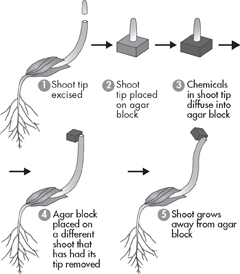Standardized Test Prep
Multiple Choice
Where in a flower are pollen grains produced?
sepals
carpels
anthers
ovary
Which part of the flower develops into a fruit?
pollen tube
sepals
stigma
ovary
Which flower structure includes all the others?
style
carpel
stigma
ovary
The trumpet honeysuckle has long, red, narrow tubular flowers. What is the most likely means of pollination?
wind
water
bee
hummingbird
All of the following are fruits EXCEPT
tomato.
corn.
potato.
cucumber.
Seeds that are contained in large, fleshy fruits are usually dispersed by
animals.
water.
wind.
rotting.
Which of the following causes fruit to ripen?
auxin
cytokinin
ethylene
gibberellin
Which is an example of thigmotropism?
change in leaf color
climbing vines
blooming
photoperiod
Questions 9–10
The results of an experiment are summarized in the art below.
Which of the following can be concluded from the results of this experiment alone?
Hormones are produced in the growing tips of plant roots.
Plants grow toward the sun due to compounds produced in their stems.
Agar blocks contain a variety of plant compounds.
Compounds produced in shoot tips can cause stems to bend.
Applying your knowledge of specific plant hormones, explain the results.
Open-Ended Response
Describe why seed dormancy is a valuable adaptation that has helped explain the evolutionary success of seed plants.
| Question | 1 | 2 | 3 | 4 | 5 | 6 | 7 | 8 | 9 | 10 | 11 |
|---|---|---|---|---|---|---|---|---|---|---|---|
| See Lesson | 24.1 | 24.2 | 24.1 | 24.1 | 24.2 | 24.2 | 24.3 | 24.3 | 24.3 | 24.3 | 24.2 |
Table of Contents
- Formulas and Equations
- Applying Formulas and Equations
- Mean, Median, and Mode
- Estimation
- Using Measurements in Calculations
- Effects of Measurement Errors
- Accuracy
- Precision
- Comparing Accuracy and Precision
- Significant Figures
- Calculating With Significant Figures
- Scientific Notation
- Calculating With Scientific Notation
- Dimensional Analysis
- Applying Dimensional Analysis





